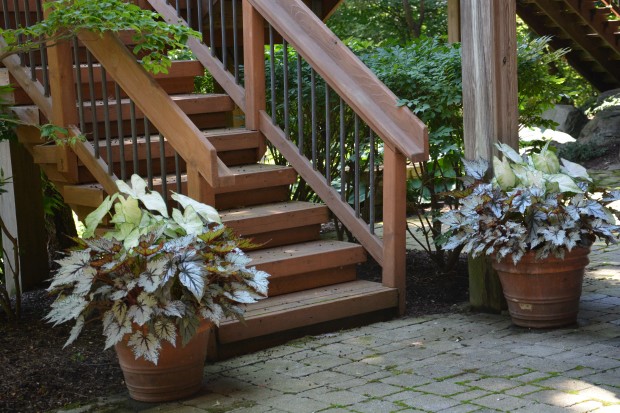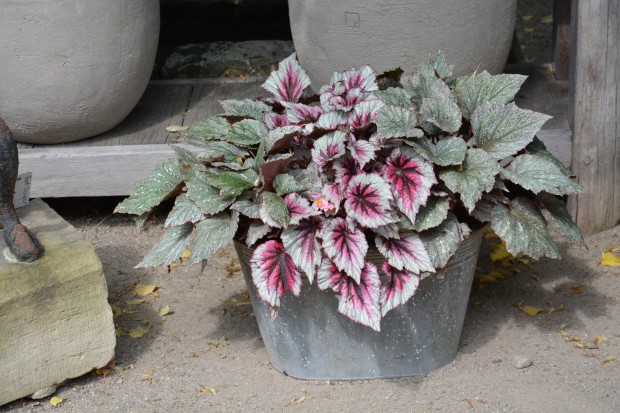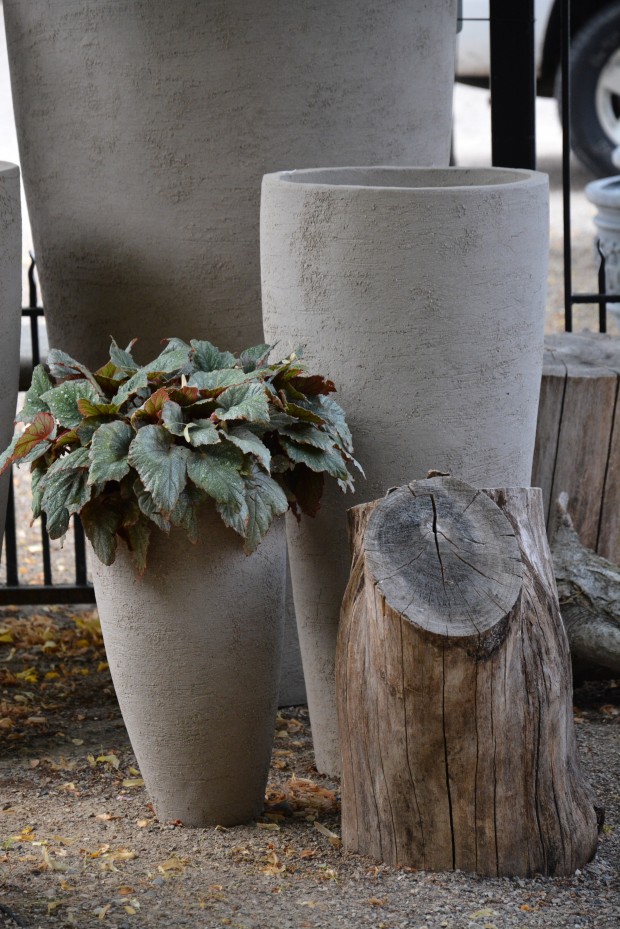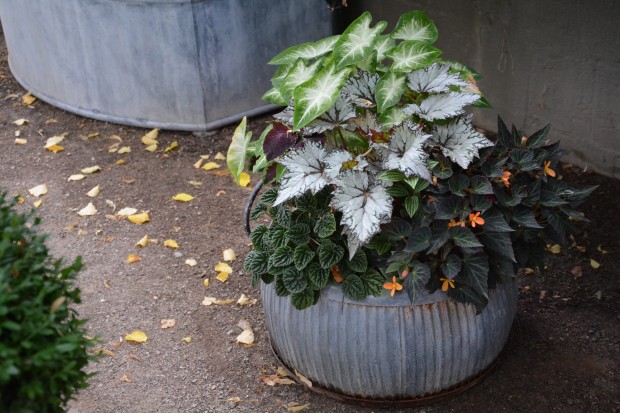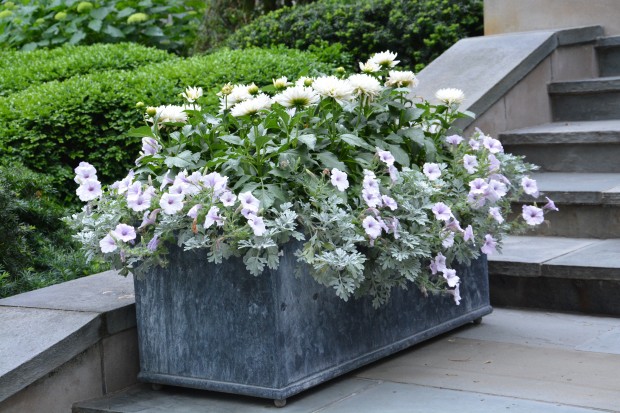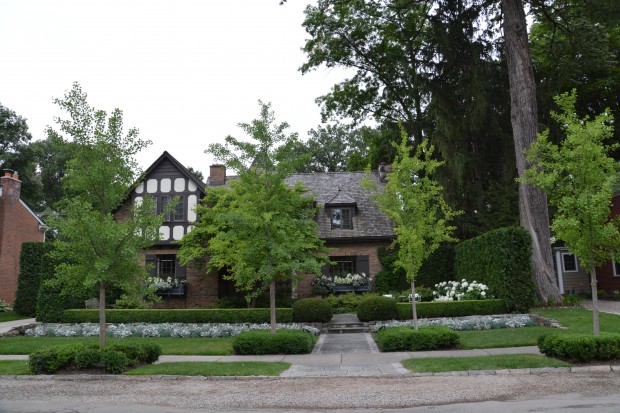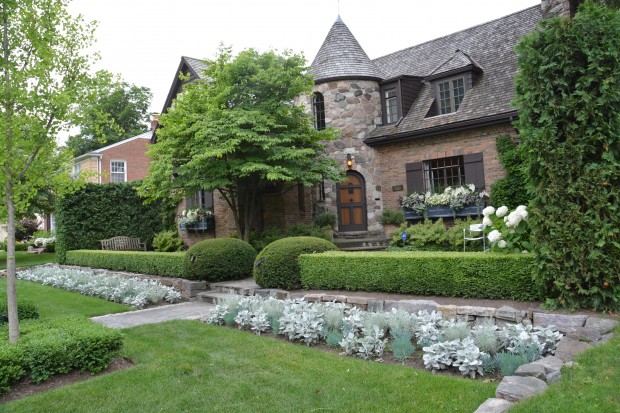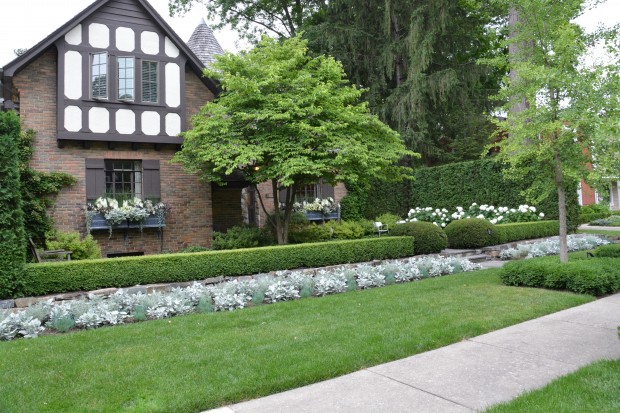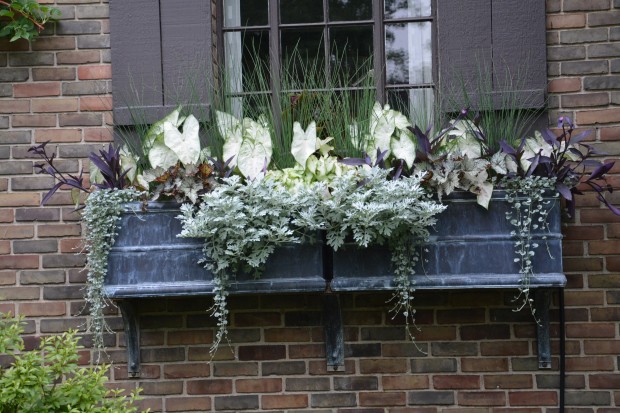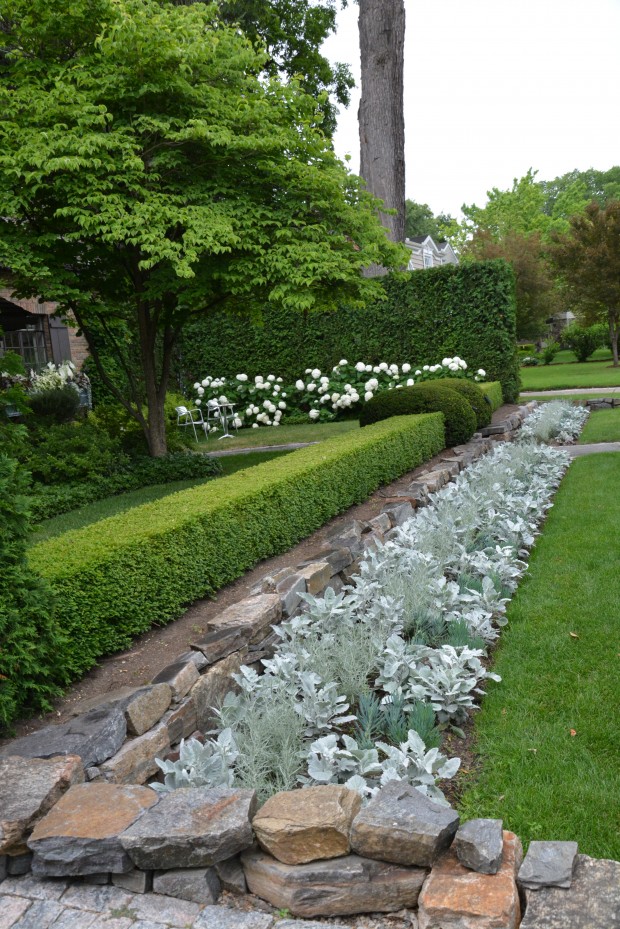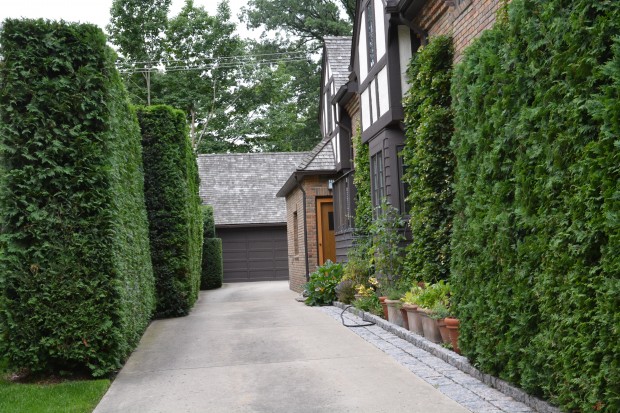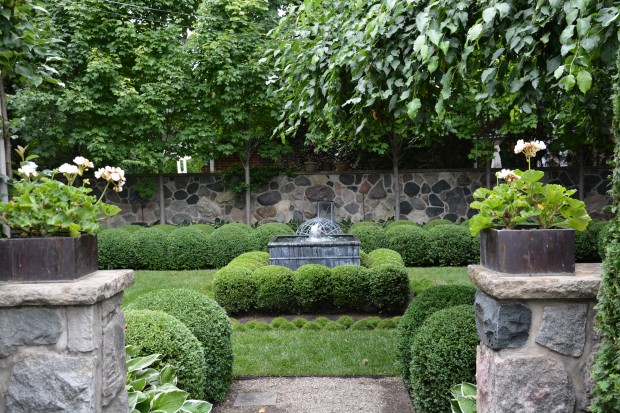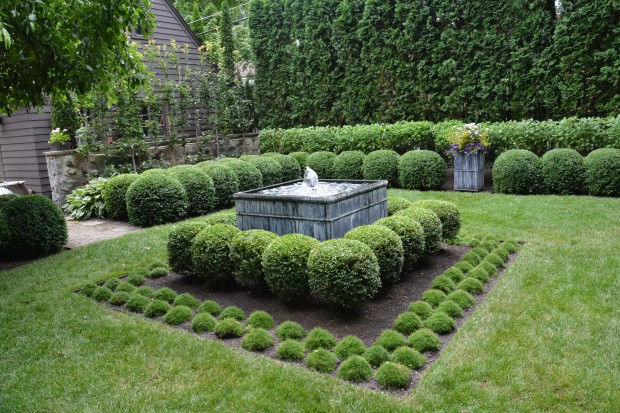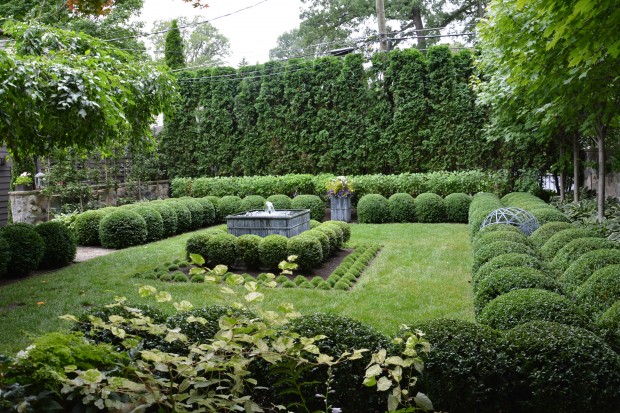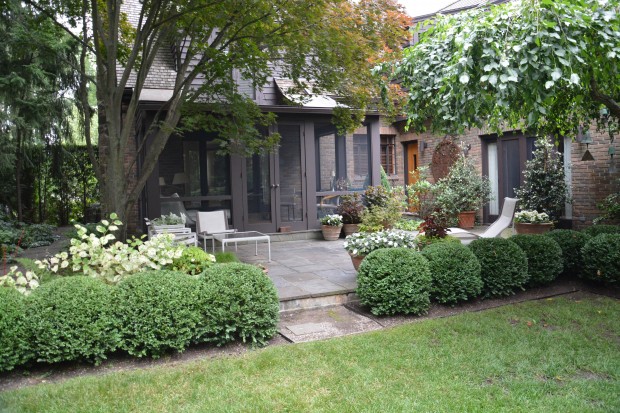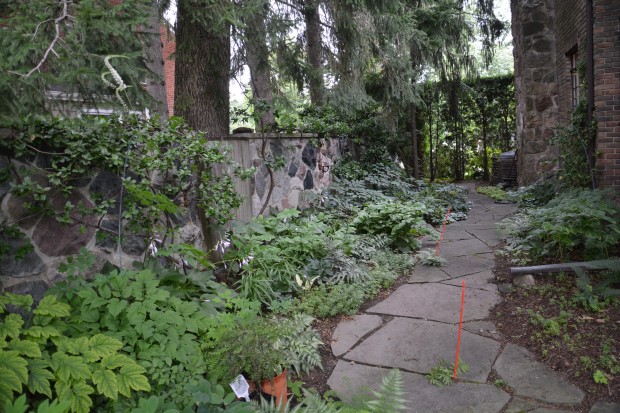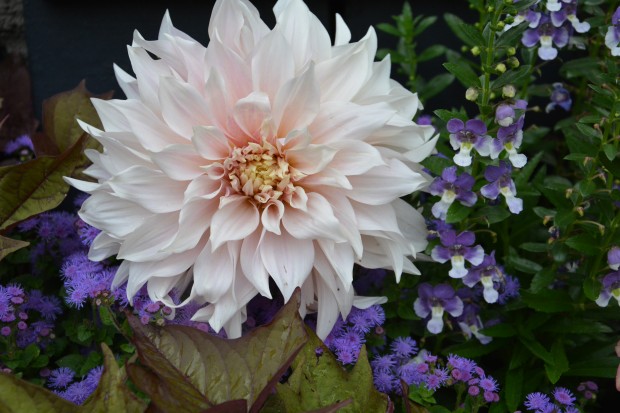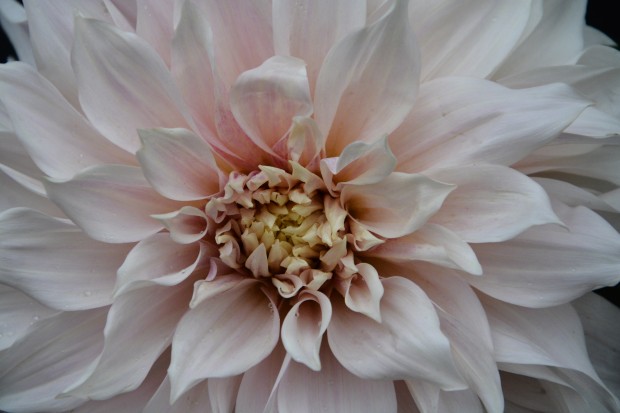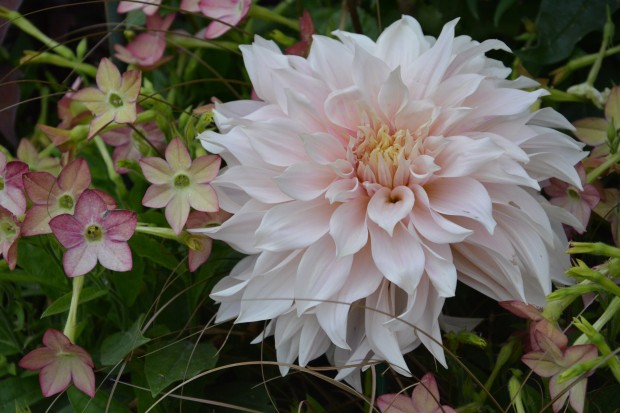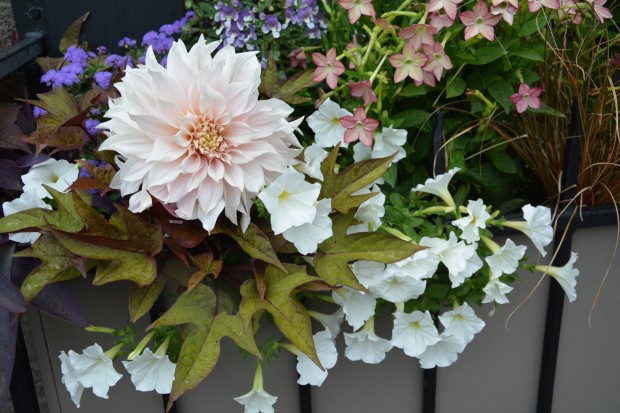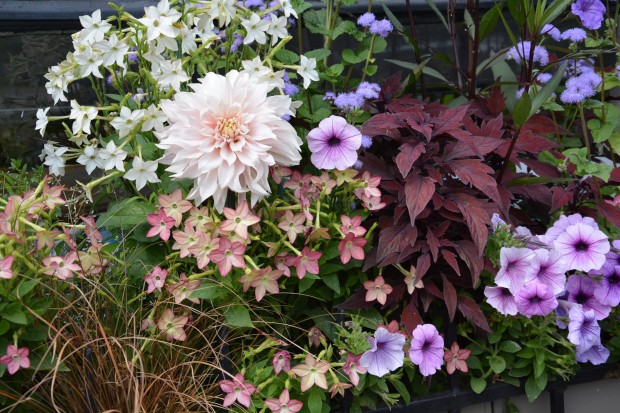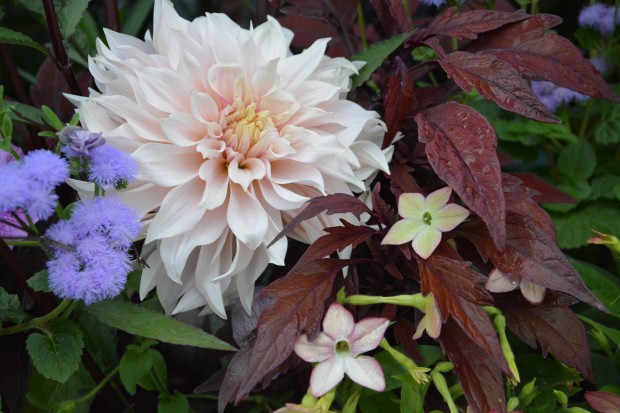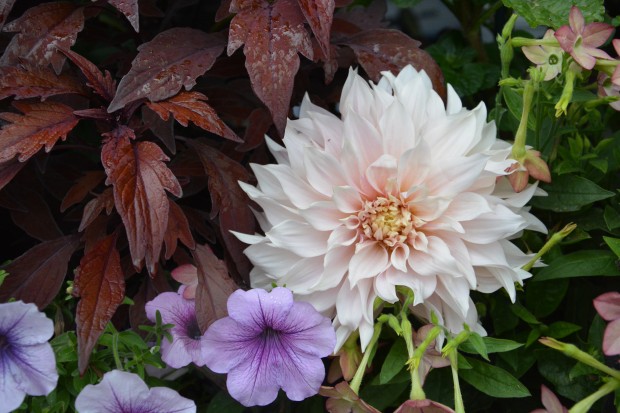I am sure you remember the astonishingly cold and lengthy winter past. The fallout from that winter was severe. So many plants damaged, or killed outright. Trying to catch up to the repair and replacement, given that it was well into April before anyone could work the ground, has been a daunting task. That cold winter has proved to be a gift that is still giving. Our summer has been remarkably, uncharacteristically, unsettlingly cool. I have no complaints about the fact that Buck and I were able to have dinner outdoors every day in July. The temperatures come 7:30 pm were neither cold nor hot-just perfectly comfortable. But for 2 hots days, and a short spell with no rain, the summer has been a dream come true for people and landscapes alike. The last week we have had driving rains and downright cold temperatures. The seasonal plants are not so happy with this turn of events.
The seasonal flowers in containers have been remarkably good, although undersized for this time of year. Tropical/seasonal/annual plants love the heat-as in hot. What is too uncomfortably warm a temperature for me is much to the liking of most tropical plants that are native to much warmer climates than ours. The boxes on the roof at Detroit Garden Works need to be planted with plants that luxuriate in high temperatures. It is a hot and windy spot, up there. My choice of a focal plant this year-Ruellia Britoniana, commonly known as Mexican petunia. “When grown under hot sunny conditions the foliage assumes a metallic bluish cast that creates the perfect backdrop for the the scores of vibrant blue flowers that appear with the onslaught of hot summer weather. The blossoms are trumpet shaped and about 1.5-2 in (3.8-5.1 cm) in diameter and are borne at the tips of the stems. Varieties with white, pink, and many shades of blue are available, as are dwarf versions that form clumps that are about 8-12 in (20.3-25.4 cm) in height. Mexican petunia is very showy when in full bloom due to the clouds of admiring butterflies that swarm about the plants.” The aforementioned is taken word for word from the floridata website. I had in my mind’s eye a hedge of ruellia 3′ tall and loaded with purple flowers-luxuriating in the heat.
 I asked George at Telly’s Greenhouse if he had ruellia in 4″ pots. He did, although the plants were small. He wanted me to leave them in his greenhouse-his hot house-for 3 weeks. They would grow faster for him in his hothouse than they would on my chilly roof. I was sure we would eventually get hot weather, so I delayed planting the roof until the beginning of July. I under planted the ruellia with several colors of angelonia. “Angelonia is an exceptional summer bedding plant that can be relied upon for dependable garden performance through the hottest summer weather”-this quote from Dan Gill. For a little contrast in color and texture, a dwarf sweet potato vine every so often, to trail. My roof garden is a perfect location for plants that thrives in high heat. As for the heat, I am still waiting.
I asked George at Telly’s Greenhouse if he had ruellia in 4″ pots. He did, although the plants were small. He wanted me to leave them in his greenhouse-his hot house-for 3 weeks. They would grow faster for him in his hothouse than they would on my chilly roof. I was sure we would eventually get hot weather, so I delayed planting the roof until the beginning of July. I under planted the ruellia with several colors of angelonia. “Angelonia is an exceptional summer bedding plant that can be relied upon for dependable garden performance through the hottest summer weather”-this quote from Dan Gill. For a little contrast in color and texture, a dwarf sweet potato vine every so often, to trail. My roof garden is a perfect location for plants that thrives in high heat. As for the heat, I am still waiting.
Those cool temperatures in midsummer? I do believe we have our past winter to thank for that. Days upon days of weather in the single digits or below zero made for a record breaking ice cover on the great lakes. Over 90% of the Great Lakes were ice covered. Friends that ice fish told me that the ice was 3′ thick on Lake Huron this past winter. Ice that thick did not melt so quickly, given our very chilly spring. If someone told me today that Lake Michigan still had chunks of ice floating around, I would believe it. How has that affected our summer? The prevailing winds blowing over frozen or near freezing lakes has made for a relatively cold summer. This week, the rains just kept coming. My ruellia and angelonia look good, just small. How have I protected my tropical plants that like high heat and hate waterlogged soil?
The proper watering of tropical/season/annual plants in ground and in containers is key to their success. In the heat of July, I water my containers every other day. I water my begonias only once a week in July-if that. Their fleshy stems store a lot of water. One bit too much water from my hose, and they will rot. The heat of July means water is evaporating out of the soil in the pots at a rapid rate. It takes a lot of attention and some skill to water just enough to keep the moisture level even. Not too much, not too little. Plants that are greatly wanting for water shed leaves, and shut down. Rescue water may revive a desperately thirsty plant, but the stress of going without can take a toll. Plants that get watered on a schedule without regard to the weather will eventually protest, and falter. Too much water is just as bad as too little. I see watering on containers now at a rate proper with 90 degree days, though many of our days have barely hit 70.
Linden trees suffering from lack of water in the heat of the summer-their interior leaves will turn yellow, and drop. A tree suffering from lack of water will shed interior leaves. The leaves at the ends of the branches are actively engaged in photosynthesis. Precious water reserves will be reserved for those leaves performing vital functions for the health of the tree. A linden tree which is over watered will send signals. The leaves-all of the leaves-wilt, and eventually yellow. Leaf drop will be considerable. This silver cascade dusty miller has been over watered. The interior leaves are yellowing.
Container plantings that are not doing well right now can largely be attributed to over water. When the temperatures are cool, and the overnight temperatures downright cold, water less. Maybe a lot less. Maybe not at all. The usual watering routine does not apply in a season like this. I always put my finger in the dirt down to my knuckle before I water. If the soil sticks to my finger, I don’t water. If the knuckle test says don’t water for 10 days, I don’t water for 10 days. If the soil slides off my finger, I water. Past this general rule, great watering becomes an art. A great diagnostician/gardener is an artist at heart. If one plant in a container seems dry, I water one plant. If it is 95 degrees, and I need water to soak a container, I may fill that container with water 3 times before moving on. When in doubt, I pass on the water.
Many factors influence the performance of plants. Placing the plant in the right place comes first. Light and water are crucial secondary elements. In shade, in cool temperatures, and in rainy weather I water tropical plants less. My hardy ferns and European ginger love all the rain we have been getting. My landscape is thriving, happy with all of the unexpected water from the sky. They have so much more potential for drainage than a plant in a pot.
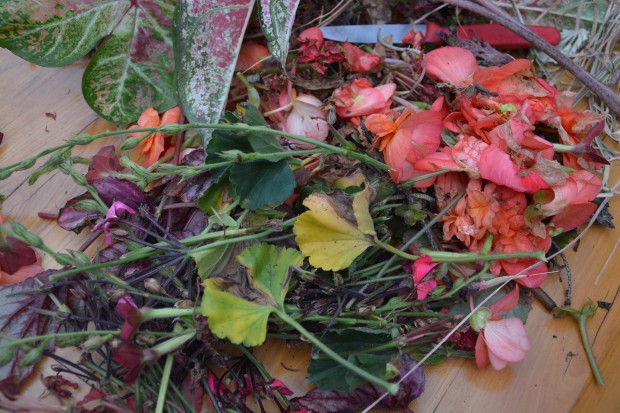 If your annual plants have leaves that are pale or yellow green, if they look peaked, fungus marked, black and mushy, or otherwise headed to a watery grave, shut off the hose. Keep that hose in neutral in cold and rainy weather.
If your annual plants have leaves that are pale or yellow green, if they look peaked, fungus marked, black and mushy, or otherwise headed to a watery grave, shut off the hose. Keep that hose in neutral in cold and rainy weather.
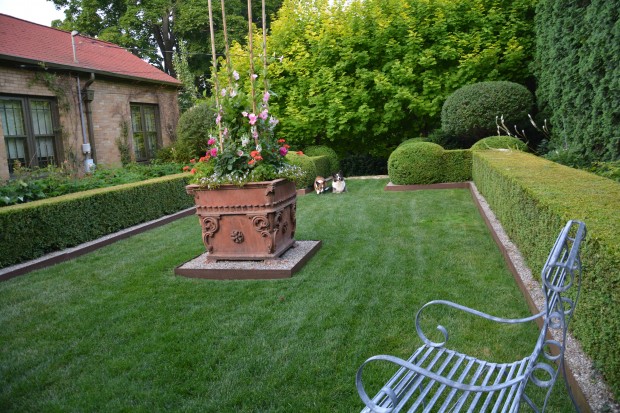
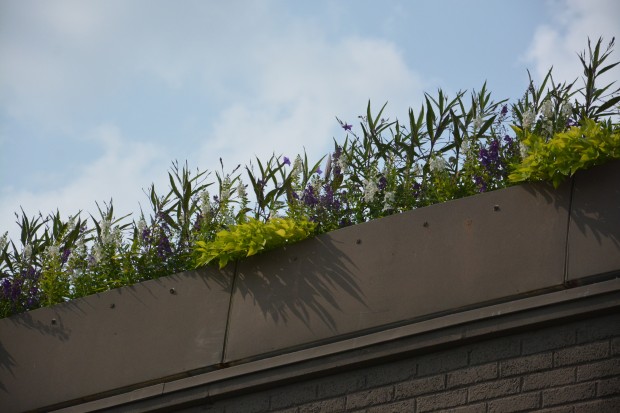
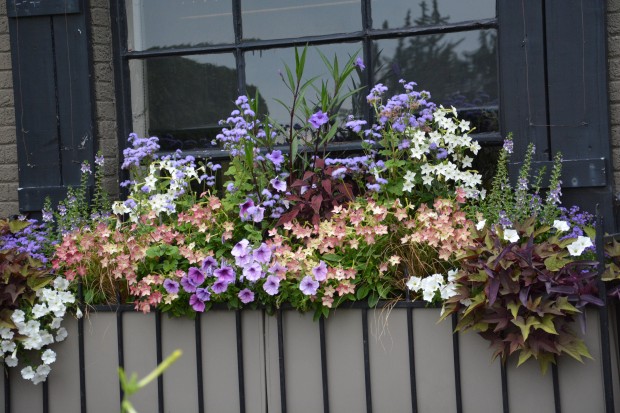
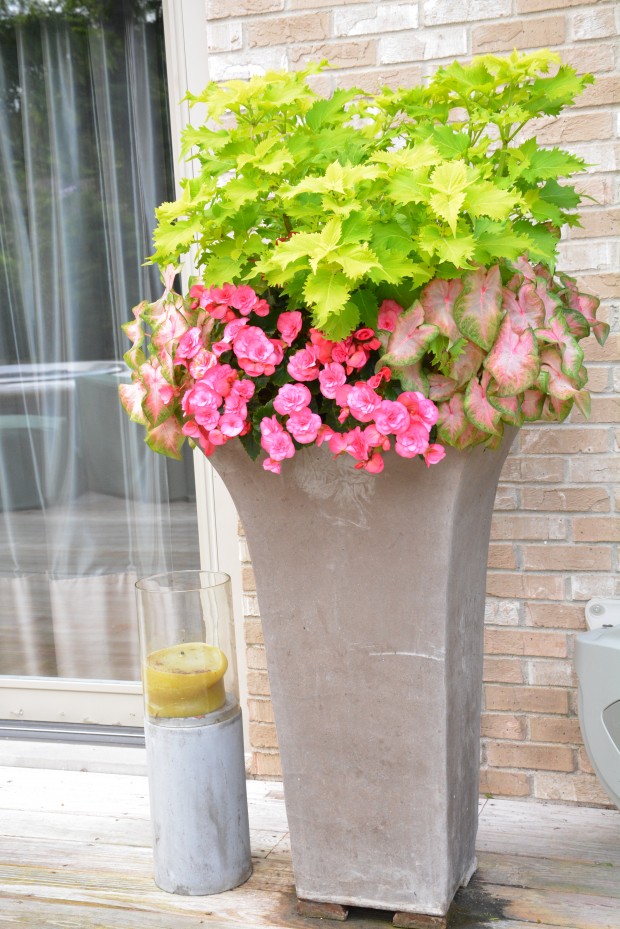

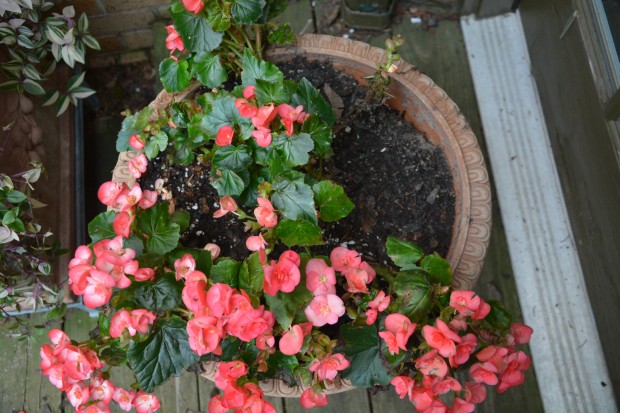

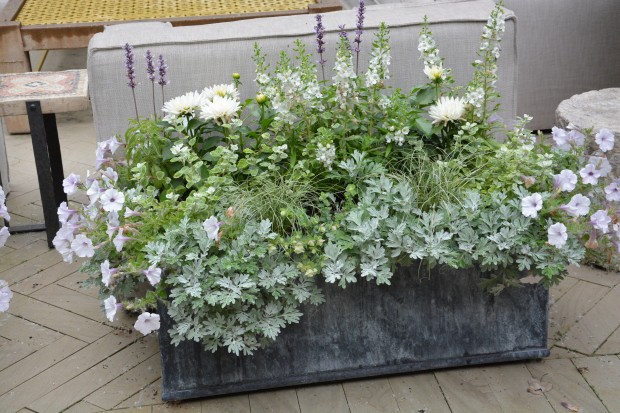
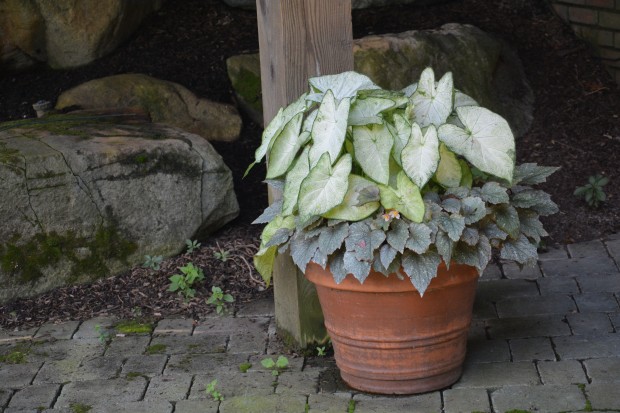
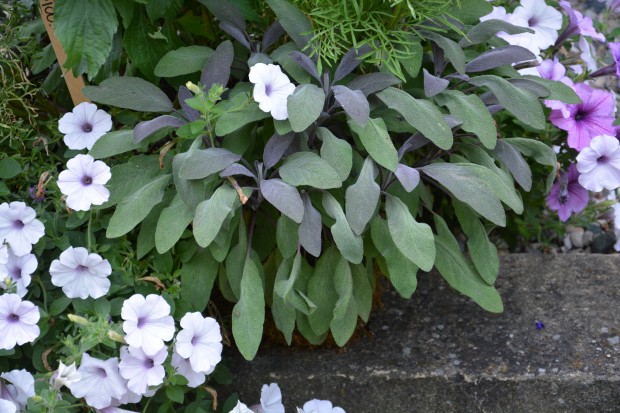
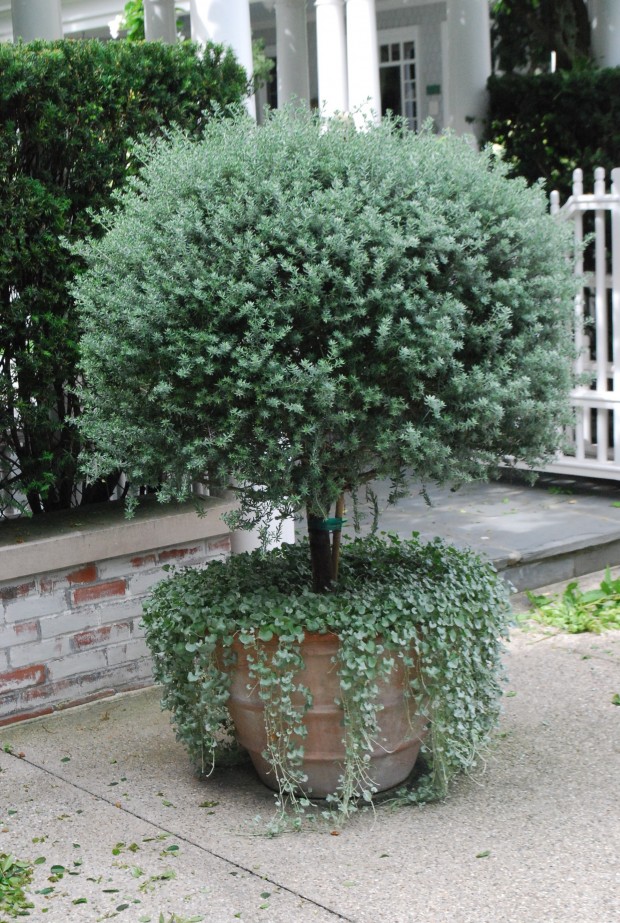
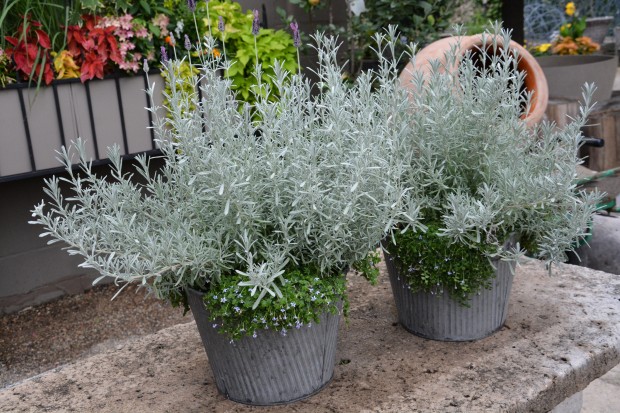
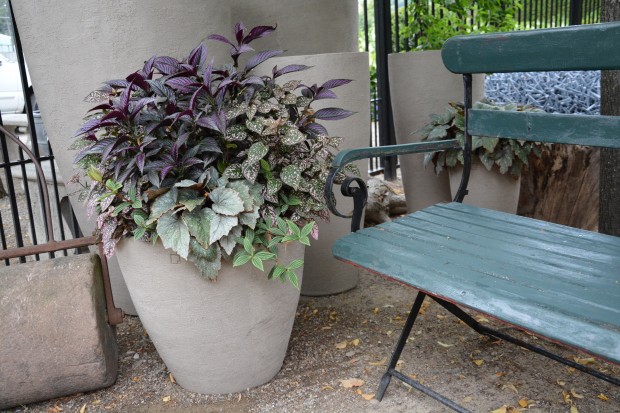
![Hudas-05-20-475x356[1]](https://deborahsilver.com/wp-content/uploads/2014/07/Hudas-05-20-475x3561.jpg)
